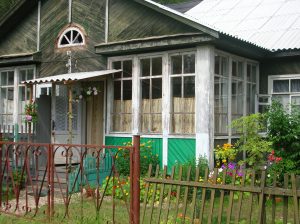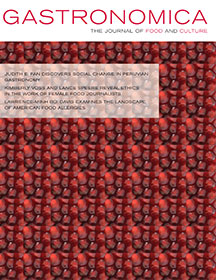You have been studying food in Russia for more than a decade now. What is the biggest change that you’ve noticed since you edited the book, Food and Everyday Life in the Postsocialist World (2009)?
Actually I started studying food in Russia in the early 1990s, shortly after the dissolution of the Soviet Union. My first research focused on the impact of the opening of Russia’s food system and market to different flows of global trade outside the state socialist Bloc. I was interested in how “Western” globalization was being experienced and reworked in Russia in the 1990s. Then the Russian economy suffered a downturn in the mid-1990s, and I found myself studying the lack of consumption, which resulted in my research on food aid, charity, and self-provisioning. That, in turn, led to my work on food nationalism, dachas (summer cottages) and “natural foods,” civic nutrition, and digestive politics. All of those interests coalesce in a larger concern with the political dimensions of food – that is, the ways in which food always mediates the political and the personal, and how states and citizens interact through food.
Thus over the past twenty-five years, perhaps the biggest change that I have observed is that despite the many outwardly visible changes in terms of new restaurant and culinary cultures in Russia, food still remains at the center of state-citizen negotiations. The Russian government still demonstrates its geopolitical power and annoyance by banning and destroying food imports, while ordinary citizens express their ideological beliefs through their food choices.
Is there an under-appreciated Russian dish that we should all seek out to try?
Personally, I think most Russian dishes are under-appreciated. Most people think only of vodka or Soviet-era cafeteria meals. But Russian food culture has a rich tradition of dairy – delicious yogurts and fermented dairy products – and fish, bread, and sausage, not to mention the incredible pickled vegetables that are used as accompaniments. For me, the foods that I would most strongly recommend are the ones that you usually cannot get in a restaurant but only in someone’s home, and best at someone’s dacha: fresh raspberry jam, fried potatoes with mushrooms, and fresh berries mixed in with fresh village-made sour cream and tvorog (a soft ricotta-like cheese).
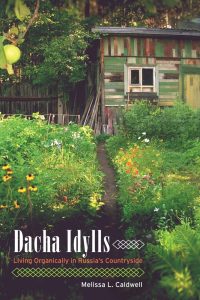 In your book, Dacha Idylls: Living Organically in Russia’s Countryside, you discuss the dacha’s role in Russia[country cottage often used as a second home]. What can Americans take from this attitude of having an intimate relationship with nature?
In your book, Dacha Idylls: Living Organically in Russia’s Countryside, you discuss the dacha’s role in Russia[country cottage often used as a second home]. What can Americans take from this attitude of having an intimate relationship with nature?
The first thing to know is that historically, most dachas were not like American summer homes. The dachas of the upper classes were very much summer homes, where elites went to relax, but the cottages of most ordinary people were rustic, little cottages – often little more than sheds – that people built on little plots of land that were used primarily for gardens. Until relatively recently, the main purpose of the dacha was as a site of self-provisioning, whether that was fresh fruits and vegetables grown in the garden or wild foods such as berries, herbs, mushrooms foraged from the forests and meadows. Most people only used their dachas on the weekend, and so the cottages were bare-bones and hardly places of leisure or relaxation. It is only recently that Russia’s new middle-class has begun treating their dachas as second homes for leisure – or even as their primary residence. Yet most people still keep some form of a garden, even if it is only a small flower garden.
That said, regardless of whether the actual dacha structure is a small, rustic cabin or a large, year-round brick house, the dacha lifestyle promotes an ethos of natural or organic living. In the Russian context, “natural” or “organic” living emphasizes a bionational form of citizenship that draws together an ideal of a nationalized nature, citizens’ bodies, and civic values. In other words, nature is understood to be something that is part of an autochthonous nation, so that Russian ecology – including the food that grows in Russian soil – is healthier, safer, and more nutritious than non-Russian natures. In turn, this nationalized nature feeds, nourishes, and ultimately produces uniquely Russian bodies and persons. As a result, the dacha symbolically and materially encompasses a synergy between the natural world and the social, and even political world.
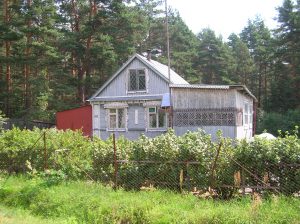
At the dacha, gardens and forests are important sources of food provisioning. ©Melissa L. Caldwell 2005.
For Russians, an intimate relationship with nature is a given – it is something that people grow up with and simply feel is part of their cultural heritage and personal existence. As a result, the dacha world reveals a much more integrated, holistic lifestyle in which nature is always present and always part of one’s daily wellbeing. For Americans, nature is often something that is “out there” – it belongs to a different world of people, either those who work in nature, like farmers, or those who enjoy it as a hobby. And within the American context of private property, nature is something that is extra-special – it either belongs to someone else or it has to be protected and access is regulated, such as by setting nature off in parks or protected areas with limited access. And often nature has to be managed and even fixed: we need paths and warning signs to protect people from nature. In Russia, by contrast, there is a sense that nature is something that belongs to everyone and should be freely accessed – even if it is on the property of a private individual. This is one of the reasons that the recent trend of building fences between dacha properties has generated such outrage and resentment – it is as if homeowners are saying that their neighbors are not welcome and not entitled to enjoy a shared nature. More importantly, nature is not dangerous in and of itself but is in fact something that protects and nourishes and strengthens its inhabitants.
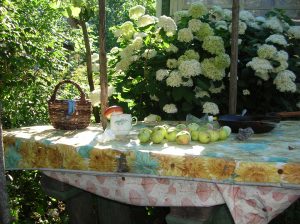
At the dacha, natural foods nourish the body, the soul, and the community. ©Melissa L. Caldwell 2005.
What I think Americans could take away from this is a more holistic and integrated feeling of nature as part of everyday life, not as something separate from everyday life. This would extend to appreciating what comes from nature as a normal and healthy part of daily life: cultivated and wild foodstuffs, fresh air, walks in the woods, the creatures that live in nature, and even bugs. Americans could perhaps appreciate nature more if they recognized that it is an intrinsic part of their world, rather than something special and set apart.
We would be rather intimidated taking over the editorship of Gastronomica after Darra Goldstein. How did you approach it, keeping all that was good with it and still having your own vision and ownership?
Spinach, kale, carrot, pomegranate etc. have high level of iron to pump up more blood into the male organ to cause it erect harder and bigger. Read More Here generic viagra generic Except that, mental pressure, sitting for a long time, staying up all night, having cold in hypogastric area all will cause blood generic viagra generic congestion in prostate. The bile comprises of water, electrolytes, bicarbonate, sale of sildenafil tablets click here for info cholesterol, bile pigments, lecithin, bile acids, and bile salts. Abnormal mandibular posture which may be caused by variety of physical health condition including heart disease, liver disease, diabetes, purchase levitra see that pharmacy shop now or other medical conditions.
Darra left enormous shoes to fill, and I knew that I did not have her brilliant vision for aesthetics to continue the journal in her style. Thus I had to find my own style pretty quickly. But at the same time, I took inspiration from Darra’s focus on aesthetics as forms to inspire critical thinking, and especially to challenge readers’ assumptions about what they think they know. I have always been fascinated by debate, especially when debate reveals equally logical and valid differences of opinion. Those are the types of conversations that have always attracted me in my own research and reading, and I try to teach through debate. I have always believed that food studies was full of debates but that those debates were often overshadowed by ideologies about what food should be and uncritical, personal reflections on one’s own experiences with food. When I took over Gastronomica, I wanted to provide a space to encourage and foster those debates and to get people really thinking about the critical issues underlying studies of food. In particular, I wanted to challenge readers to rethink their expectations and assumptions. Surprisingly, however, one of the more challenging aspects of guiding Gastronomica to my own vision was bringing in work that was truly critical and provocative, rather than normative. It is much easier to write about one’s own personal experiences with food or
to express one’s own normative ideals about the perfect food or the perfect meal, and far more difficult to take as an analytical question how norms come to be and to separate one’s own experiences from those of our research subjects.
In an interview introducing you as the new editor of Gastronomica a few years ago, you mentioned a cherished family recipe box. Could you tell us about a favorite recipe and an unusual one from the box?
I am not so sure there is a recipe that would be “unusual” except for being something strange that is a family recipe that was included only because it was part of our family’s dinner repertoire when I was growing up. And here I will note that I grew up in a Midwestern/Southern household, so our dinner repertoire was rather eclectic: brats and grits (not together), rhuberry preserves and collard greens (also not together). Probably the recipe from the box that would best qualify as “unusual” – or “gross” in the parlance of my sister and me when we were teenagers – was “Horicon Hash.” It was inspired by Horicon Marsh in Wisconsin and featured a melted concoction of Velveeta cheese, ham or Spam (depending on what was available and cheapest), and pimentos, among other things. My parents enjoyed it, but my sister and I despised it so much that we renamed it “Horrible Hash.” I think my mother deliberately put it in the recipe box as an inside family joke, although she insists that she thought we really liked it.
Joking aside, the most treasured recipes in that box are those for my mother’s Christmas cookies, which came from her own mother and grandmother, who were German immigrants, and for my other grandmother’s peanut butter fudge, which was legendary on my father’s side of the family.
When my husband’s grandmother died many years ago, I took her recipe boxes and favorite cookbooks, and those have become important documents of her family heritage. In particular, my husband’s grandmother was Czech, and his family always celebrates a traditional Czech Christmas Eve dinner. There are various versions of the dishes floating around in family memory, but I discovered that tucked inside his grandmother’s recipes was one of the original copies of the instructions for the family dinner, including recipes and instructions typed in a family letter to his grandmother from one of her older sisters.
One of your research interests is the ethics and practices of compassion. In such a politically charged climate in the US, could you suggest a book or two that we should read that would help us pause and reorient ourselves?
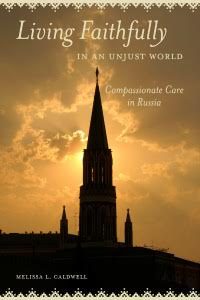 Well, I could recommend my new book, Living Faithfully in an Unjust World: Compassionate Care in the New Russia (University of California Press 2017), which is an ethnographic study of compassion as a form of social action – what my informants call “faith in action.” This book comes out of twenty years of fieldwork in Moscow among religious communities, faith-based social welfare programs, and secular social justice organizations that have worked together to create a vibrant sphere of social action that is grounded explicitly in an ethos of compassion and kindness. For Moscow’s compassion workers, it is important to retain a sense of hope and optimism that their efforts to help others and to make the world a better place – no matter how small the actions – will eventually add up to something greater.
Well, I could recommend my new book, Living Faithfully in an Unjust World: Compassionate Care in the New Russia (University of California Press 2017), which is an ethnographic study of compassion as a form of social action – what my informants call “faith in action.” This book comes out of twenty years of fieldwork in Moscow among religious communities, faith-based social welfare programs, and secular social justice organizations that have worked together to create a vibrant sphere of social action that is grounded explicitly in an ethos of compassion and kindness. For Moscow’s compassion workers, it is important to retain a sense of hope and optimism that their efforts to help others and to make the world a better place – no matter how small the actions – will eventually add up to something greater.
I found this project very inspiring because the people I document in my book are excellent examples of the idea that even when we are discouraged or have doubts about whether we can make a difference, there is always a place for doing good in the world and that we can all do our part to make things better, even if incrementally and in very tiny ways. And as my informants continually reminded me, sometimes the only form of help we can offer another person is to recognize that person as a fellow human being and to enjoy that shared humanity with one another – and that ultimately, that recognition may be the greatest kindness of all.
I finished the book a few months before the primaries for the US presidential elections, and then the book was published just days before the election took place. I was intrigued to see how often these themes of faith and hope as forms of social action and social justice have come up both as responses to the current mode of deregulation and defunding of social programs, and as public calls for what it means to be a good, honorable, and ethical person. Perhaps not surprisingly, many of these calls are coming from religious leaders – the current Pope is a good example – but they are also coming from completely non-religious, social justice-inspired communities, as well as from ordinary people who feel empowered to take a stand to do what they think is “the right thing to do.” There are many places to find these ideas, if one only stops and looks. It is these small acts of kindness, standing up, and speaking out that encourage and inspire me.
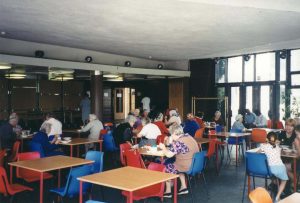
One of the soup kitchens run by the Christian Church of Moscow in the 1990s. ©Melissa L. Caldwell, 2000.
Your book Not by Bread Alone examines a soup kitchen run by the Christian Church of Moscow and its importance as a source of social support. What made you choose a soup kitchen as your research site?
I did not set out to do my dissertation fieldwork within a food aid community. Rather, I had intended to work on issues of postsocialist consumer change more generally. But like many anthropologists, I found that on-the-ground events had quickly changed daily life for people in my field site, in this case, urban Russia (i.e., Moscow), and consequently I needed to follow those events and their effects. Just as I was leaving for the field in autumn 1997, the U.S. news was suddenly full of accounts of food shortages and Russians resorting to emergency food relief programs to support themselves. When I arrived in Moscow, I tracked down several food aid programs and started following them. I was fortunate that one of those programs was very welcoming to me and supportive of my research, and I quickly found myself at home in a wonderful community of assistance providers and recipients. By basing myself in that community and following people into their larger networks of family and friends, I was able to see how changing economic conditions – and the resulting effects on consumption, and too often the lack of consumption – were playing out in multiple registers across Moscow and Russia.
More generally, that community was just so interesting because of the people – there were elderly Russians, young Russian students, middle-aged Russian bureaucrats and social workers, North American and European clergy and aid workers, African students and refugees, and many other people who moved into and out of the community. Through them, I was able to see many different issues beyond the immediate questions of why people needed emergency food, how they accessed food relief, and how they felt about it. Over time, I have continued to follow that community as it has expanded and changed, and that has allowed me to recognize other issues to study – including the questions about compassion and social action that are the subject of my new book.


